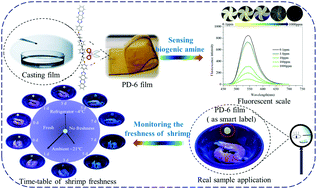Fabrication of a solid sensor based on a phenazine derivative film for enhancing the sensing properties of biogenic amine and applying for monitoring shrimp freshness†
Abstract
In practical applications, fixing a fluorescent sensor on a solid composite film matrix can settle the boundaries of keeping the sensor in the solution state. Herein, we first presented a preparation of anime-response membrane by utilizing the edible gelatin as a film-forming skeleton to immobilize the dual phenazine derivative (PD-6), acting as amine-responsive functional units to fabricate a novel solid sensor. In order to ensure the sensor (PD-6 film) is available in the actual application, the mechanical properties, anime-responsive performance, and further application for monitoring shrimp freshness were fully characterized. Those observations indicated that the PD-6 film not only enhanced the sensitivity to anime, but also strengthened the application potential as a solid fluorescent sensor with flexible recyclability and favorable antibacterial properties. It is hoped that this valuable strategy could open a new avenue to overcome the application limitations of the sensor in the solution state.



 Please wait while we load your content...
Please wait while we load your content...